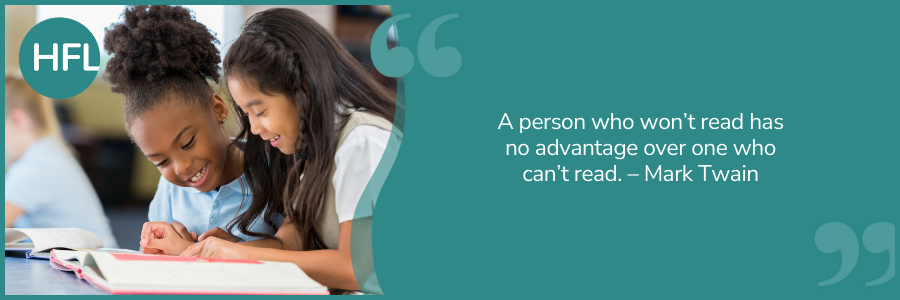

The phrase “it takes a village to raise a child” originates from an African proverb and conveys the message that a team of many is required to promote an environment of security, ambition and enthusiasm which encourages children to grow and pursue their hopes and dreams.
This was definitely the case with the promotion of 'reading for pleasure' in our school. Nothing was going to be achieved by one person in isolation. It was going to be an ongoing journey for the whole school and the community around us to change our ethos. It was not going to happen overnight.
I became English lead in June 2021 and was a passionate advocate of the power of books within our curriculum. The right texts on our shelves and throughout our curriculum would provide an insight for the pupils into all our school values: growth, cooperation, inclusion, ambition, independence and curiosity. The right texts should provide images of all pupils as champions in their own lives and support them to build empathy with the lives of others.
My initial step, with support from HFL Education advisers, was to take a walk around our wonderful school to take a fresh look at the literature available to our children. Although we had many texts on the shelves, it was clear that these could do with updating to represent a more diverse range of protagonists and authors. It was also obvious that the global pandemic had changed our collective use of the library and had heightened the need for a wider range of genres and text types within classroom ‘book corners’ to inspire and re-engage children in books.
So, we started small! I put a box full of new and diverse picture books in the staffroom with a star rating review sheet for the staff. I also put in a range of books that they might want to read for themselves, just to remind people of the joy that reading can bring on a personal and individual level. The ‘Book Fairy’ started delivering wrapped books to each class at the start of each half-term which created a buzz of excitement amongst the children and teachers! What were they going to receive next? Most importantly, we prioritised reading by giving teachers and children the time to just read and enjoy. Across the school, tweaks were made to the timetable to ensure this could work.
Alongside these changes to motivate and enthuse teachers and children to read, we developed our guided reading lessons and implemented a new phonics programme. This was a collaborative piece of work, alongside our feeder infant school, to ensure children who required further phonics instruction would continue to have a consistent approach on arriving at our school.
Then, we had to turn to our village…
With encouragement from SLT, our governors, a local English hub school and HFL Education, we began our journey to improve our range of ‘real’ books and inspirational literature on our shelves and in each classroom. We were clear that the focus of any money spent on developing our reading for pleasure culture was to be on books themselves.
As a junior school, we wanted the pupils to experience how to make informed choices about their reading materials in the same way that adults would if they were to go into a bookshop and scan the shelves. Each teacher had autonomy over their own classroom environments, and I think you will agree that the end results were worth their efforts:


Reading was clearly elevated to centre stage within each classroom. Children were talking about books and year groups and staff were swapping texts. We next wanted that motivation, enthusiasm and engagement to grow and help our school community to come together with a shared understanding of the joy of books.
Alongside our values and whole school ethos, we wanted to use texts in our weekly assemblies. With the support of our Deputy Head, Mr Chris Amoss, we mapped out a cycle of texts that linked to a weekly value and world or school event. This became the weekly text that was displayed in the hall, linked to each daily assembly and was read and referred to by different members of staff each day. These texts were also linked to our whole class guided reading curriculum, our PSHE curriculum and several cross-curricular subject areas. Through these text choices, children are now able to make connections, develop vocabulary through repeated exposure and see links between the books they are reading and other areas of their learning.
A great example was when our Computing Lead, Mr. Adam White, shared Troll Stinks by Jeanne Willis and Tony Ross on Internet Safety Day. This great, child-friendly picture book got everyone talking about safe use of their phones and the importance of using kind words on online platforms. We also shared the Little Leaders: Ada Lovelace biography, for Ada Lovelace day. This gave great cross-curricular links with science and shared female STEM figures, underpinning our school values of ambition and growth.
The impetus of these changes continues to grow: there is a buzz about reading and books in the whole school that is taking off. Staff, governors and pupils are all talking about the importance of reading for pleasure and more importantly the pleasure they themselves are getting from reading! Children are developing knowledge of different genres and text types and can now be heard making recommendations their friends, saying: “If you liked this, maybe you could try this next.”
Our reading journals now contain conversations between teachers, children and parents about new vocabulary they have learned together, or what they particularly enjoyed about a certain text or a favourite character. They ask their class teacher as an ‘expert’ reader for recommendations of what to read next.
Furthermore, the conversations in the book corners are now about the books. We’ve overheard:
With the support of our village, who knows where we can go next! The journey to changing our attitude and motivation towards reading for pleasure is just beginning but there are plans afoot. It cannot be accomplished by an individual, rather it takes a whole team of people behind a common goal.

Have you ever taken the time to reflect on the expectations you have of the children and adults in your early years provision? I was once told at university, that everything I did as the teacher would impact the outcomes of my class, be that positive or negative. Over the years, I have come to realise how true this to be and the times I found this most accurate would be when I let my expectations slip.
Firstly, having high expectations of the children and adults in your school/setting does not mean that you must operate a more formal style of provision or routine. Vice versa, having a more formal teaching and learning approach does not indicate that you have high expectations. Your expectations will be intrinsically linked to your personal values, knowledge and experiences, therefore requires a level of individual reflection.

I wanted every child in my class to be successful and achieve to their fullest potential. To ensure this happened I would spend time reflecting on the needs and interests of my cohorts, the types of interactions that happened in the environment and sections of the routine that felt ineffective. I did not do this daily, but I did spend some of my non-contact time considering whether my expectations were appropriate and where adjustments were required. Even now, whilst out of a classroom environment, I learn from teachers and practitioners I work with and consider how I might have adjusted my expectations further.
My fundamental expectations were for every child to become confident, independent learners and this looked different for every child. Children need to be provided with clear boundaries and appropriate levels of challenge. They need to be able to fail safely and recover positively, have ownership over their learning alongside taking direction to exceed it and develop new skills to apply in different contexts. Most importantly expectations must be consistent between all adults working in the provision to ensure children feel secure and able to function in the school/setting environment.

Before children start - What are your expectations for when children start?
Effective transition is important for the children and their families, but it is also important for early years practitioners to enable them to prepare their environment and curriculum to meet the needs of the new starters. When we think about establishing expectations, they must begin from day one. As an example, I had a clear expectation that all children would learn to hang their belongings on their pegs, however, I also had an awkward shaped cloakroom space that I shared with an adjoining classroom. When I knew that I had children starting with mobility/accessibility requirements, I would ensure that the lowest, end peg was allocated to them to ensure they could hang their belongings independently along with everyone else. My expectations remained but the adaptations I made ensured success for the child(ren).
Early days - How do you implement your expectations?
Establishing class/setting ‘rules’ are a usual occurrence in the first few days of term. It is important to ensure everyone is involved and that the ‘rules’ are highlighted and referred to frequently. It is also important to teach children about the expectations of the provision, especially in the beginning. One way in which I would achieve this would be to plan all adult led activities in the first two weeks, or longer if needed, for teaching children how to use and replace resources, both indoors and outdoors. This enabled adults to interact with children on a playful level, build secure relationships and identify any concerns early on. This allowed for adaptations and enhancements to be made as required to the environment and the routine. Every time an enhancement was made, children were informed, and expectations reiterated. On the return from long periods of absence, it was also expected that adults spent time reinforcing expectations and boundaries.
Throughout the year – How do you reinforce your expectations?
You will continually encounter barriers throughout the year which will require addressing. This does not mean lowering expectations but simply reviewing what is working well and where adaptations are needed. Ensuring groupings of children were mixed according to attainment levels was always more successful as it allowed all children to be challenged and supported appropriately. As much as I would have liked my class to be a big, happy group of friends, as in adulthood, you just do not get on with some people. My expectation, therefore, was that we were a team, which meant we had to be respectful of everyone and had to work together when necessary. I would set challenges during school holidays such as ‘do your coat up by yourself’ or ‘read to your toys’. This boosted their confidence when they returned after attempting the challenge. Children were always given time to master these skills and adults were well trained in effective encouragement.
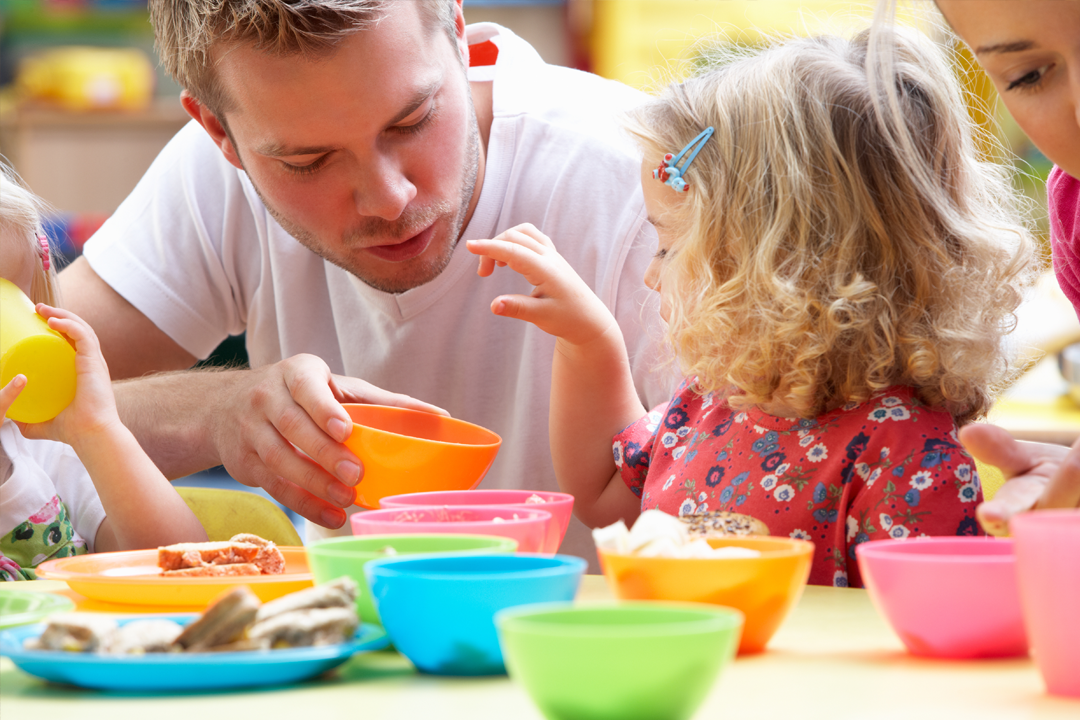
An effective routine with a balance of adult led and child-initiated learning opportunities is important to maximise chances of embedding your high expectations. I was once asked, prior to the change in ELGs, whether my reception class knew their number bonds to 10. Hand on heart, I had not directly taught number bonds to 10 but my class did in fact know them. How? Because I expected every child to return the Numicon pieces to their individual boxes in the ‘correct’ order, which happened to be additions to 10. They could also recognise halves and quarters, positions and directions and simple time facts that they had picked up through everyday conversations, experiences, and expectations – not formal adult led sessions. As mentioned earlier, a more formal provision will not equate to having high expectations. Knowing your children is vital and being reflective of your values as an EYFS practitioner imperative to establishing high expectations.
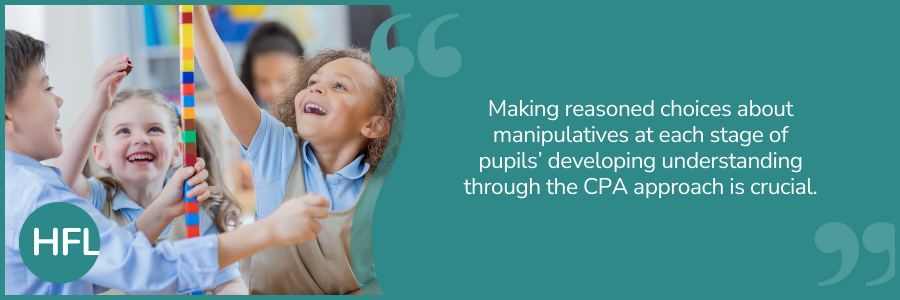
Through my work in schools recently, I have been having similar conversations regarding the effective use of manipulatives. Teachers and subject leaders tell me that they follow the CPA (concrete, pictorial and abstract) approach in the lessons for their year group but have admitted that although they may use a resource to teach an element of maths, they are not always aware of where that leads to in future years, or what has come before in terms of CPA.
For example, base 10 is used superficially to help reach an answer in formal addition, but the starting point of pupils building numbers, exploring number magnitude, regrouping ten ones into one ten and flexible regrouping may not have been considered.
In this way, CPA is used as a crutch rather than to develop deep conceptual understanding.
The guidance report, ‘Improving Mathematics in KS2 and KS3’, the Education Endowment Foundation (EEF) recommends teachers should ‘use manipulatives and representations’ and goes on to explain that ‘Teachers should ensure that there is a clear rationale for using a particular manipulative or representation to teach a specific mathematical concept.’
This sentiment is echoed in the equivalent EYFS and KS1 document ‘Improving Mathematics in the early years and KS1’. There needs to be a clear rationale for the choices made, both how and when, pupils move through the CPA process towards mastery of the concept.
Let’s track one concept through the CPA approach, across multiple year groups, and consider the choice of resource, and more importantly how and when it is used, so that it can deepen a child’s understanding as well as enable them to apply the knowledge in other ways.
It begins in EYFS where pupils begin to subitise small amounts (recognise how many there are without counting).
Using tens frames, pupils are encouraged to see numbers within numbers as they conceptually subitise the number 8 through seeing a group of 5 and a group of 3.
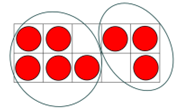
This leads to exploring the equals sign as a balance. At this point, pupils should be using the concrete resources and be beginning to explore a pictorial representation to allow them to internalise their understanding and ‘own’ it.
Following that, in year 1, they can begin to move towards the abstract notation by recording number sentences such as 5 + 3 = 4 + 4.
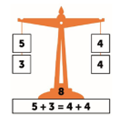
Pupils could record this pictorially through drawing the counters into a pre-made tens frame or move towards using Cuisenaire to build the numbers.
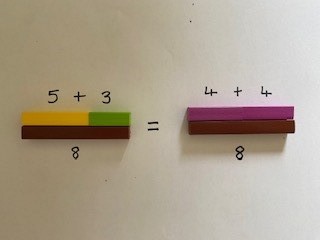
The choice to shift the resource to Cuisenaire at this point is so that pupils move from thinking about the numbers as individual ones and begin to group them together.
They can subitise 5, so the rod representing 5 deepens their understanding of unitisation – the concept that 1 unit could represent any amount.
Then we move towards Year 2, where the numbers get bigger and pupils explore the same concept, but at a deeper level, maybe attempting problems involving missing numbers to really test their security of understanding. Once pupils understand equals as a balance, they can begin to explore Equal Difference.
The concept of difference is tricky for many pupils, often because adults very quickly jump to the end point, which is subtraction. But difference is not subtraction, it is a comparison.
To find the difference, we must compare two quantities, side by side, and see what the gap is between then two. Ultimately, children will need to see that the effect of finding the difference is subtraction, but they need to get there slowly, by going back through the CPA approach again.
To start, pupils can line up 2 small quantities such as 8 and 5. To reduce working memory at this point, it is necessary to work with single digit numbers again, so that pupils can concentrate on the strategy. Underneath they record the abstract notation 8 – 5 =

From here, encourage pupils to fill in the ‘gap’ with yellow counters and reach the answer of 3.

Now there is an opportunity to play around with the calculation, placing 1 more red counter onto both amounts and noticing that the difference of 3 remains the same.
9 – 6 = 3
10 – 7 = 3
11 – 8 = 3
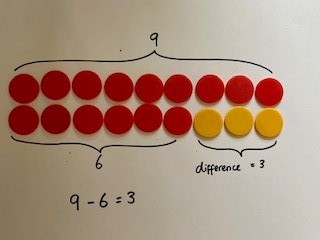
Being systematic in this way will assist pupils in seeing that some calculations are easier to solve than others. They will most likely express that 10 – 7 is easier than 8 - 5 as it is a number bond to 10.
At this point, we want to help pupils see the link between difference and subtraction, so an alternative resource such as a number line is now introduced. By lining up the 2 number lines first, to mimic the counters model, pupils can identify the difference of 3 and cut out a strip of paper to fit.
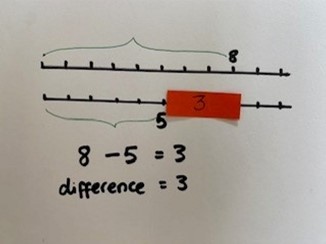
Now reduce this again on to 1 number line and place the difference in between the 8 and the 5. Write the calculation 8 – 5 = 3 and repeat, shifting the strip of paper up and down the number line to create other subtraction questions, ensuring the conversation is focused on ‘what stays the same?’ and ‘what’s different?’
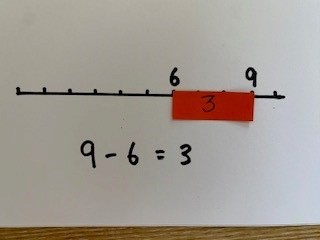
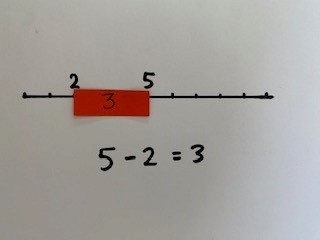
Throughout this process, there are ample opportunities for pupils to record their explorations pictorially, whether that be child-led for the counters or on pre-drawn number lines as a scaffold.
Once pupils have understood the concept of equal difference around Year 2/Year 3 and have reached the generalisation, ‘If I add or subtract an equal amount to the minuend and subtrahend, then the difference will remain equal’, this can be applied for larger numbers, increasing through Year 4 and into Year 5, where pupils may be exposed to a calculation such as 6 million subtract 4,345,576 or decimals.
Many children will attempt this question using the formal method of subtraction, which is a valid option. However, there are multiple opportunities for pupils to make errors with this strategy, as they will need to regroup in every column.
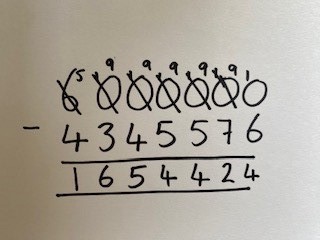
Whereas if they apply the strategy Equal Difference, they can subtract 1 from both numbers and instantly the calculation is more managable and less prone to error.
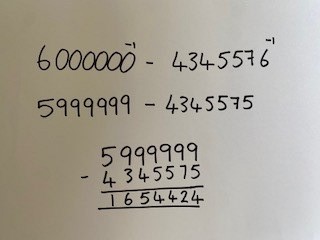
At this end point for the strategy Equal Difference, maybe around Year 4 or 5, pupils are now mostly working abstractly, but because they have worked their way through the CPA process, they have a deep understanding of the concept and as a result are able to apply to any calculation if it makes it more manageable. They have become more flexible in their approach, taking note of the digits involved in the calculation and so choosing the most efficient method.
Opportunities for the careful shift of manipulative at crucial moments occurs throughout the curriculum. In part 2 of this blog, we will look another sequence of learning, focused on learning multiplication facts, and how effective use of the CPA approach can deepen pupils understanding and aid retention.
To summarise, here are a few things to consider when using a manipulative to develop conceptual understanding:
And most importantly…
To keep up to date: Join our Primary Subject Leaders’ mailing list
To subscribe to our blogs: Get our blogs straight to your inbox

Arousing a child’s curiosity is an intrinsic part of education and engagement. It’s why Floella Benjamin’s Coming to England has a version for each primary key stage and why Benjamin Zephaniah’s Windrush Child is chosen for students at secondary school. Children ask questions about our world, its history and people, and they want answers.
This year, Windrush Day on June 22nd will mark 75 years since the Empire Windrush docked at Tilbury bringing the initial symbolic generation of people from countries in the Caribbean to Britain. It’s a great opportunity to teach young people about events leading up to and following that day. There are opportunities to make links to lots of curricular areas such as literacy, music, art, sport, geography, PSHE and drama. Through a comprehensive study of the Windrush generation alone (1948 – 1971), pupils can learn about Britain, legislation, the commonwealth, World War 2, the NHS, transportation migration, colonisation, discrimination, tolerance, achievement and success.
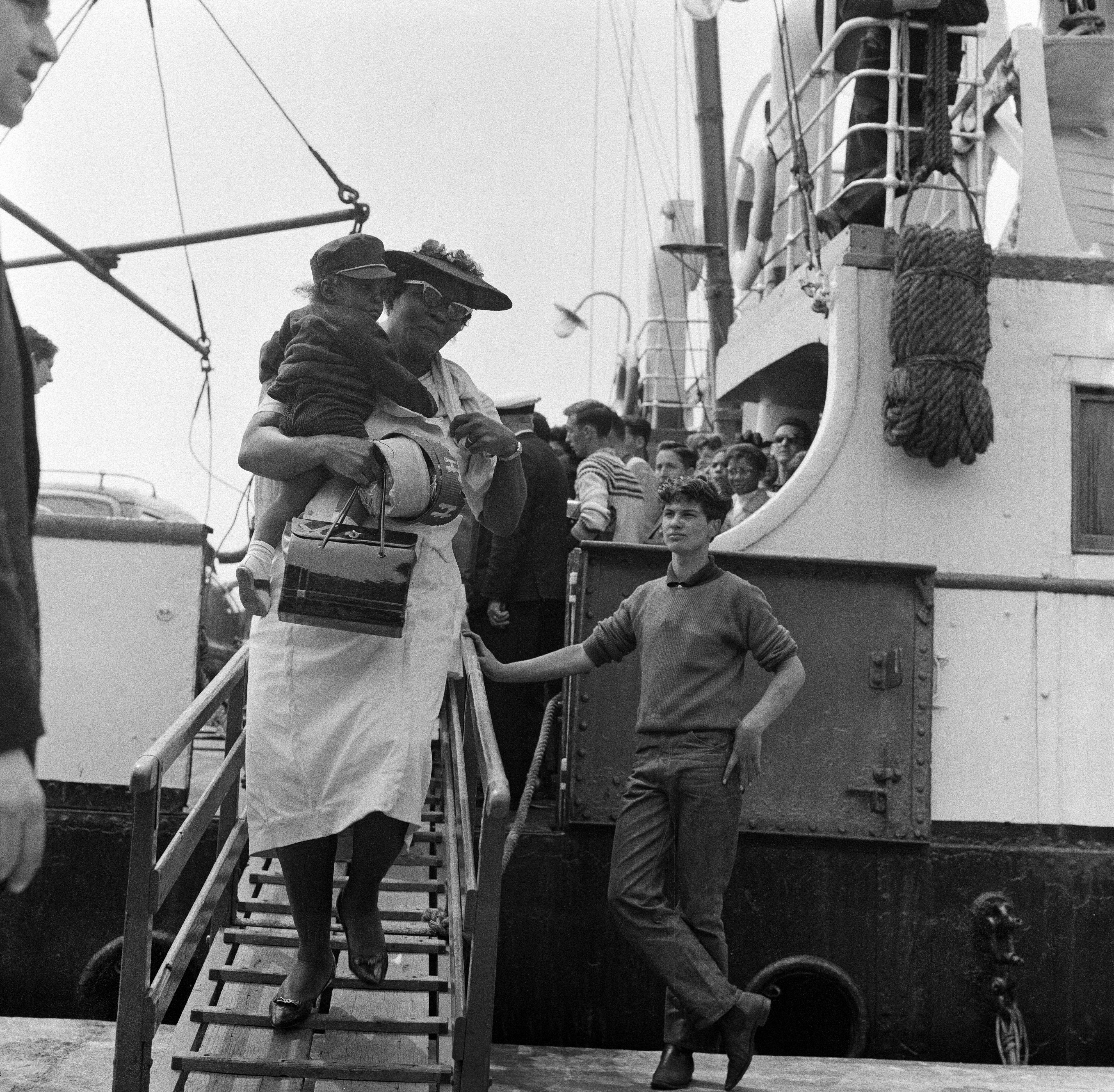
Teachers can use Windrush 75 to teach young people about significant events and people. This fits neatly into the key stage 1 curriculum, changes within living memory, and an aspect or theme within British history that extends pupils’ chronological knowledge in key stage 2. The curation of materials on the Herts Memories website is a fantastic place to start as it features newspaper clippings, photos and recordings. From the Stories of Success, children can learn more about the local hidden heroes like Henry ‘Roy’ Brown who played for Watford and Reba Younge who came to Stevenage as a nurse and later retrained to become an educator and anti-racist campaigner. Eric Blakeley and Gurdev Delay produced a booklet for North Herts Museum entitled North Herts African Caribbean Roots which they dedicated to the Windrush Generation and features photos, pictures, memories, poetry and insights into the lives of those who made Hertfordshire their new home. Perhaps you could find out from your school community if anyone is part of this generation and would like to visit the school and share their experience, skills, photos and memories.
This could be a great opportunity to teach children about oral history using the Barnardo’s oral history project. They could listen to testimonies, read first person accounts (inspire me-the story of Windrush) and read poetry and stories from and about this generation. At HFL Education, units have been produced to support teaching children in primary school about Windrush. If you haven’t already, have a look at the schemes of work on National Windrush Day, Coming to England, and Overheard in a Tower Block, as well as a wide array of resources on antiracism.
Kickoff@3 organised a wonderful celebration and charity football event that took place at Oaklands School on 24th June. There was a musical performance by St Albans community choir, stalls, food and entertainment. If you missed it, you can also listen to Lily May’s BBC3 Counties Radio Music show on the BBC iPlayer (Sunday 18th June 2023) as this was dedicated to celebrating Windrush. Next Page Books in Hitchin have planned a Windrush-themed storytime followed by a craft session which took place on 24th June. They were also sharing Windrush books on their social media. There was also an event at the Watford Museum on 22nd June which included a short presentation on tracing your Caribbean family history with stalls from local community groups too.

David Olusoga’s key stage 1 and 2 versions of Black and British provide young people with accessible information and a timeline about Windrush. In these texts they can explore the role of WW2, the 1948 British Nationality Act, the creation of the NHS, hiring policies with London Transport, government legislation, cultural shifts and impact. Pupils will also be introduced to the Bristol Bus Boycott of 1963 and the Race Relations Act of 1965, as well as the Notting Hill Carnival. For leaders wanting to deepen their pupils’ knowledge, you could also refer to the History Association, where Helen Crawford Primary (journal issue 94) provides excellent guidance such as How can we teach this valuable topic? If this is an area of interest, you could find out more from the books that shaped the black British experience list.
There is a veritable smorgasbord of events taking place in relation to the anniversary of Windrush. For your one-stop-shop, look no further than Windrush75 Network who are working to make the year one of national celebrations. There are lots of events, talks and exhibitions to choose from. Royal Museums Greenwich and Caribbean Social have partnered to create a range of celebrations which you can attend in person at the National Maritime Museum, listen to or watch online. Find out more here. The V&A Museum have created a whole season of events, some of which will close at the end of the year. There’s a webinar about the diversity coin, display on tracing legacy, a hidden Caribbean tour, portraits, workshops and talks. BBC Arts have created a documentary which explores the Windrush: Portraits of a Pioneering Generation. You could also pass through Waterloo Station and visit the National Windrush Monument created by Basil Watson.
With passenger lists to explore, photographs and art from then and now, newspaper articles, documentaries and much more, all readily available, there’s never been a better time to explore and engage with Windrush. Finding out more, imagining yourself in a different place and time, researching and discovering, using stories to learn, empathise and care, are key steps in childhood and lifelong learners.
Ignite your curiosity. This anniversary - Windrush 75 – could be enlightening.
If you would like staff CPD on race equity, join us at our Antiracism Training: How to lead with confidence.
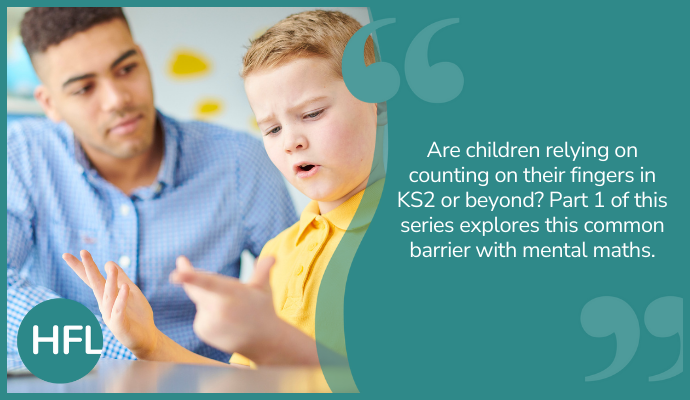
Why bother to teach mental calculation strategy to solve 9 + 5? Does it matter if the only way a child can solve this is through using the ‘counting on’ strategy? Isn't it more important that they get an accurate answer?
Yes, it does matter that they have other ways to solve this simple calculation.
For a Year 2 child, the difference in time to solve 9 + 5 through ‘counting on’ or employing another mental strategy (such as rebalancing the calculation to 10 + 4) would be minimal. However, when the same child is presented with a situation involving them solving 49 + 35, the difference in processing time increases significantly. Confidence in attaining the accurate answer could be higher (rebalancing would allow 49 + 35 to become 50 + 34).
When presented with a calculation, children will apply the strategy that has been the most successful for them. If they have previously been using ‘counting on’ and got their reward tick, that will confirm to them that the most important part of the calculation is to get the correct answer. I am not arguing that the correct solution is not important; it really is, but it’s not the only part of the process we should show the children that we value.
The problems start when the calculations involve two-digit numbers, then three-digit numbers, then decimals, and they still default to this method. The volume of data to process has increased significantly. The difference in processing time between the count on and a more efficient mental strategy has now become critical.
Let's look at the volume of data they are dealing with if they try to solve the two different calculations. When solving through the count on or indeed the count back strategy, the children are doing a 'double count', meaning that they need to know how many counting steps (or acts) they have to do (which they usually track on their fingers) and also where in the number sequence they are on each count.
Figure 1 shows an example of how a child might solve 9 + 5 using the count on strategy.
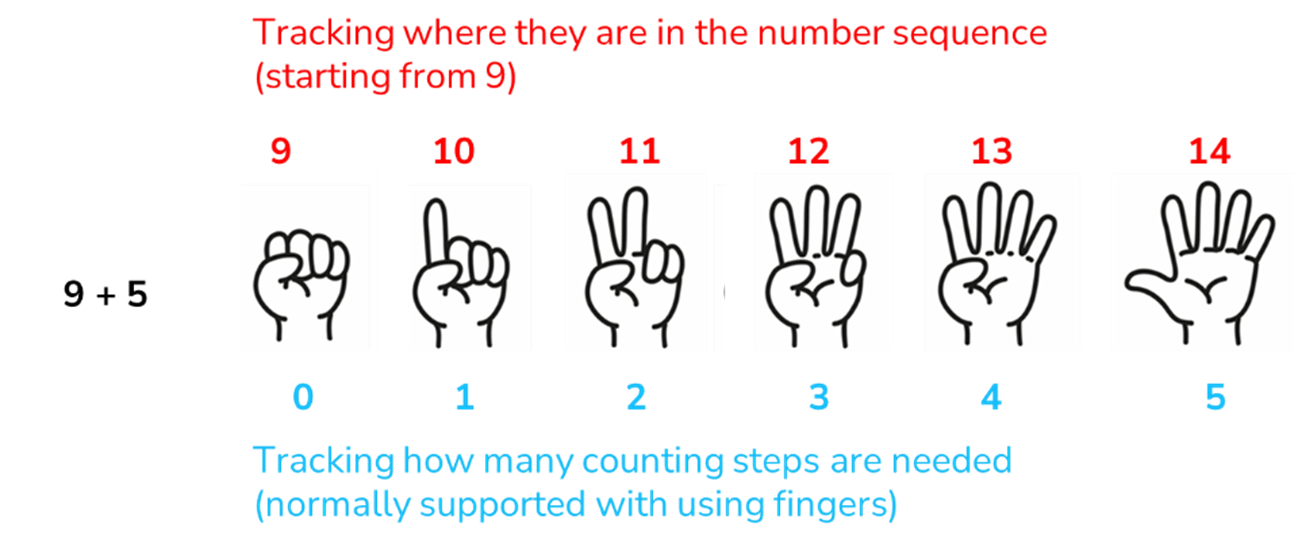
So far, so good; they have enough fingers to track the count, so the counting act doesn't take too long. In this case, the count on strategy would be appropriate for the children to use.
But what happens if the child tries to apply the same strategy to 49 + 35?

How will they keep track of how many counting steps they must do and how far along in the number sequence they are? They might be able to keep track on their fingers, but they will then also need to keep track of how many times they have gone through all ten fingers. They might try to verbalise the double count.

It becomes challenging to keep track of what the two counts represent and children start to get confused or skip steps in either, or both, of the counting sequences.
The volume of information for many children becomes overwhelming, leading them to become frustrated and ultimately give up, generating negative feelings and lowering self-esteem.
Mental calculation is not “being able to do the sum in your head”. It is not defined by the ability to solve a calculation without making any jottings or notes.
It is about helping children spot patterns and look for meaningful relationships between numbers, and enabling them to creatively use these to simplify calculations.
As our children pass through primary school, we need them to build strong foundations in maths. We must help them create meaningful mental images that can be manipulated and employed flexibly and creatively.
Strong mental maths skills are essential for children to develop.
They:
Dr Abadzi, a cognitive scientist at the University of Texas, states that ‘people are basically prisoners to their working memory’.
During the Making Fluent and Flexible Calculators project, I have often seen clear examples of children being prisoners of their working memory, trying to hold too much information at once. I have seen them trying to keep the double count in their heads, using their fingers to track the count, tapping the table with their fingers, and using tracking jottings (see figures 2 and 3).

Figure 2 shows a child's work showing ‘count on’ tracking jottings to solve 16 + 17 with common errors.
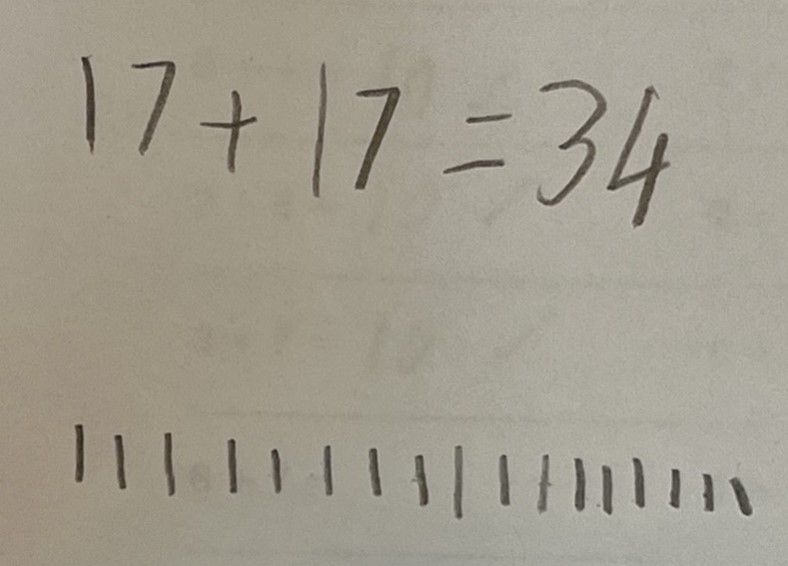
Figure 3 shows an example of a child's work showing ‘count on’ tracking jottings.
When Making Fluent and Flexible Calculator: whole class intervention teachers have assessed their classes of children, they have consistently been surprised by the high percentage of children who are still solving problems through ‘counting on’. The inappropriate application of ‘counting on’ or ‘counting all’ significantly limits their ability to engage in more complex calculations, including multiplication and word problems, as their working memory becomes cluttered.
In the absence of confidence and practice in other mental strategies, knowing and using base facts (chunked-up information which takes up less space in the working memory), the cognitive load is immense! Imagine the load when they try to do more complex calculations. They are indeed prisoners of their working memory and caught in the counting trap.
Introducing children to a range of mental strategies early (calculations involving single-digit numbers) allows them to explore them with concrete resources and more clearly see how and why the strategies work. They can find early success with various strategies.
Through early engagement in reasoning about strategies, they will understand that the strategy is of value and that they have agency over which strategy they employ and can manipulate the numbers to make more ‘friendly’ calculations, lessening the cognitive load and being playful with their mental maths.
Making Fluent and Flexible Calculator: whole class intervention is a whole class project which supports pupils to:
This project is something that all Lower Key Stage 2 teachers should engage in to enable children's ongoing success and a genuine love of maths.
Express interest in finding out more or taking part in the next round of the project here: Expression of interest form.
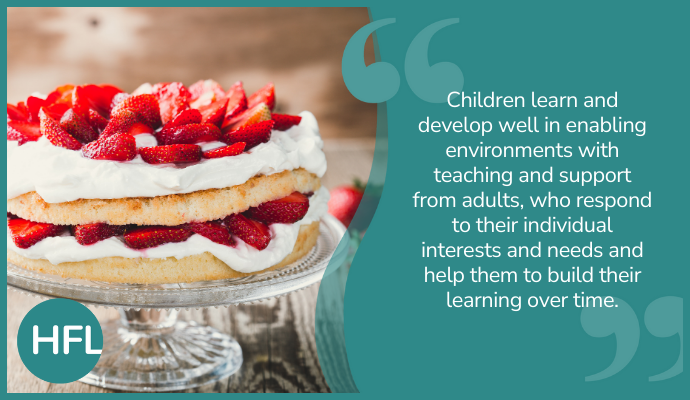
The design of your curriculum identifies the sequenced programme of ambitious, rich, and varied knowledge, skills and concepts that you believe are important for your children to learn and develop. But what role does the EYFS environment play in supporting the effective implementation of your curriculum intent and how can you ensure that you are utilising it to its full potential to maximise children’s outcomes?

Allow me to begin by sharing a personal experience of late that inspired the content of this blog. While watching a popular bakery programme, and aware of the impending birthday celebration of a close family member, I decided it was time to challenge myself. “I could do that…” I thought, as I watched the contestants construct an elaborate cake tower. No more pre-prepared sponge that I had often tried, and failed, to pass off as my own. It was time for me to take the plunge and bake my own cake. Now this may not seem like a ground-breaking decision to some, but for me, this was a personal challenge (believe me when I say my culinary skills leave much to be desired). But, in the knowledge that taking risks enables us to grow and develop, I decided it was time to realise my creative potential and try something new. The excitement of accomplishing a meaningful, personal challenge motivated me and I was fully invested.
On arriving to my local supermarket, I headed straight to the home baking aisle. The ingredients I had planned to use were nowhere to be seen. I searched around the store, frantically trying to locate the essential ingredients, which became increasingly challenging with the absence of clear, accurate signage. Eventually, I came across the sugar, however found this to be stored on the highest shelf of the aisle, ever so slightly out of my reach. On failing to locate a member of staff to assist me, I moved on to the next ingredient on the list: gluten-free flour. The horror at finding the empty space on the shelf where said flour should have been. Without this crucial ingredient, there was no way I could fulfil my goal. All those opportunities to develop my independence and creativity, learn a new skill, set my own goals, build my confidence and take pride in my own accomplishments. Gone. Feeling deflated, I selected a pre-made Victoria sponge, one I had selected many times before, and headed for the checkout.
“I thought this was a blog about enabling environments”, I hear you cry! As I stood solemnly waiting my turn at the checkout, I began to wonder what could have been. If only the shelves had been organised in a way that ingredients were accessible to me, easy to reach and clearly labelled so that I knew exactly where to find them. If only the shelves had been restocked so that the ingredients that I required to meet my personal needs were available. If only a member of staff had been on hand to sensitively support and guide me so that I could lead with my own ideas. If only the supermarket environment had enabled me to take on this new challenge and learn something new, then, perhaps, I could have realised my baking potential.
This leads us to consider the value of the EYFS environment in supporting the effective implementation of our curriculum and enabling our children to succeed in reaching the goals and ambitions we have designed, as well as those that they set for themselves. While it would have been possible for me to take myself to another supermarket to locate the resources that I needed to achieve my goal, our children do not have this privilege. We understand the significant influence of children’s experiences within their first five years on their future success and, with only 190 days in the school year to have that crucial impact, it is essential that we make every moment count for our children.
“There are three teachers of children: adults, other children, and their physical environment.”
Loris Malaguzzi
Often likened to the ‘third teacher’ (Loris Malguzzi), a high-quality learning environment is a fundamental aspect of early years pedagogy in providing high-quality teaching and learning. It is crucial that we provide children with the right foundations and support to enable them to fulfil their potential. This is achieved by carefully planning an environment that enables children to develop connections with the world around them, with themselves and others, as well as engage in opportunities to practise, revisit and consolidate prior learning, explore, take risks and solve problems. Creating the right physical and emotional environment to enable and facilitate learning is key to children’s growth and development. Therefore, we must ensure that the environment provides the resources, space, and freedom to enable children to follow their own intentions and experience the satisfaction of meeting their own goals.

“Children cannot become independent learners if they can’t see, select and access their own equipment and resources”
(‘Foundations for Independence’, Featherstone and Bayley).
In order to build children’s independence and develop their sense of autonomy, the environment must be well-organised, readily available and accessible so that children know where materials and resources are to support their play.
Resources should be carefully planned in response to ongoing assessment to ensure they present appropriate challenge and opportunities for skill progression. “If we constantly provide the same (often basic/emergent) resources, then we encourage children to revisit the same basic/emergent skills” (Alistair Bryce-Clegg). Therefore, as the developmental needs and stages of your cohort emerge and develop over the year, so too should the resources available within your continuous provision.
It is crucial for children to see themselves, their family and community and their interests represented within the environment, to motivate their engagement and build a strong sense of belonging. This is particularly important in supporting our most disadvantaged and vulnerable children to build connections, uphold a positive self-image and develop a strong sense of self-belief.
“As children become disconnected their status, sense of belonging and self-esteem diminishes, encouraging retreat”
(Dan Nicholls).

With the 22nd June 2023 marking 75 years since HMT Empire Windrush arrived in Britain, organisations and communities across the country are marking this special celebration and significant piece of our history in a variety of ways. For instance, Windrush 75 network are helping to not only raise the profile of the huge contribution made by the Windrush Pioneers, but also to “deepen the public conversation about the past, present and future of modern Britain.”
There are a number of other events taking place across the country which schools can choose to get involved in. A useful curation can be found on the Black History Month Website.
One way to introduce primary pupils to the history and significance of Windrush in British culture is by sharing some of the many beautiful books on the subject. We particularly love John Agard’s Windrush Child, Granny Came Here on the Empire Windrush by Patrice Lawrence, Windrush Child by Benjamin Zephaniah and The Place for Me - Stories about the Windrush Generation by Dame Floella Benjamin and other authors. At HFL Education, we have long admired the work of Dame Floella Benjamin, particularly her wonderful books ‘Coming to England’. The picture-book version is a rich, colourful and inspiring retelling of Floella’s true story and is both heart-warming and heart-breaking in places, with determination shining through. It is an ideal introduction to the Windrush generation for younger readers. The memoir for key stage two readers is now more than 20 years old and remains a favourite with us. Floella’s combination of courage and hope against the challenges she faced in moving from Trinidad to London are beautifully captured in transportive description.
Using Floella’s wonderful books as inspiration, we have produced a whole school writing unit plan - Explore and Engage: Coming to England - which has been released onto our resources website, PA+, to mark the anniversary of HMT Empire Windrush. Many schools across Hertfordshire have already used this unit planning to bring the school together as a community of readers and writers and some truly magnificent written outcomes have been produced.
In one of the planned lessons, the children were asked to create a poem of several stanzas, reflecting on all the things that a Windrush child would miss when they left Trinidad, and their first impressions of Britain.
With thanks to Little Green Junior School for sharing their pupils’ writing.
Juicy mangs
Warm rain
Hot weather
Colourful markets
Saying goodbye, feeling helpful
Vibrant flowers
Friendly faces
Tropical watermelon
Fun on the beach
Saying goodbye, feeling helpful
Squawking seaguls
Making friends
Flying fish
Floating skyscrapers
Saying goodbye, feeling helpful
Cold and lifeless
Heavy metal
Trees like Christmas cards
Nervous and anvious
Saying goodbye, feeling helpful
Angry faces
Drab colours
Rouring hiss
Quick as an arrow
Saying goodbye, feeling helpful
Lily
Glorious island in my heart,
The swaying palm trees waving goodbye in the gentle breeze,
The waves lapping in time with the wind almost making a beat for me to hear,
The boats go by breaking the pattern in the waves developing a ripple in the small tide.
Glorious island in my heart,
Look far out at your island from this great mighty ship,
Your island turns to a strip then to a dot and then to nothing but the blue sea,
As you near your destination the sea changes colour to a dark gloomy brown,
You enter the port in thought of the new island that awaits you.
Glorious island in my heart,
You disembark this mighty ship and enter Southampton harbour,
Lots of people walking around you bewildering you,
They wear grey suits much different to life in the town that you once loved and still do now,
You stop near a platform and a big monstrous train comes blundering to the platform.
This is only the beginning...
What adventures await you Windrush child?
Long endless platforms in underground chambers with storming train that never end that twist and turn like a snake,
Automatic doors that open and close,
confusing announcements that make you freeze,
Tall lifeless buildings that stand up high,
The grey stormy days that never end,
New beginnings, opportunities, a new start.
Ghaazi
Glorious island, never forgotten,
Colourful clothing blowing in the gentle wind,
Scorching hot grounds is what you lived with,
Clear waters, building up the temptation to dive in.
Glorious island, never forgotten,
Generous people waiting to meet,
Instead of sleeping, you have a midnight feast,
Delicious food ready to eat.
What adventure awaits you Windrush child?
Tall dull trees are what you shall expect,
Rain and snow is what awaits,
Racism and judgment for the colour of your skin
Dull and dark as you wait in line for your trim
It’s not as bright as you might expect.
Alex
Oh how I will miss you beautiful island.
Pristine white curtains covering the light,
reflective glass-like sea,
grated cocoa being grown in the field above.
Oh how I will miss you beautiful island.
Exotic sweet smelling flowers which cover the landscape,
years worth of hovering butterflies and exotic parrots,
Hollywood movies, that would put a smile on somebody's face.
What adventures await you Windrush child?
Buildings like hands, grasping the clouds,
rumbles of trains sending shockwaves beneath the feet.
New world, new place, new start.
Jake
Access this free whole-school plan, based on Floella Benjamin’s marvellous books ‘Coming to England’, to support your school in learning about HMT Empire Windrush.
We would love to see your pupils’ work, so if you tweet about it, do tag us @HertsEnglish.